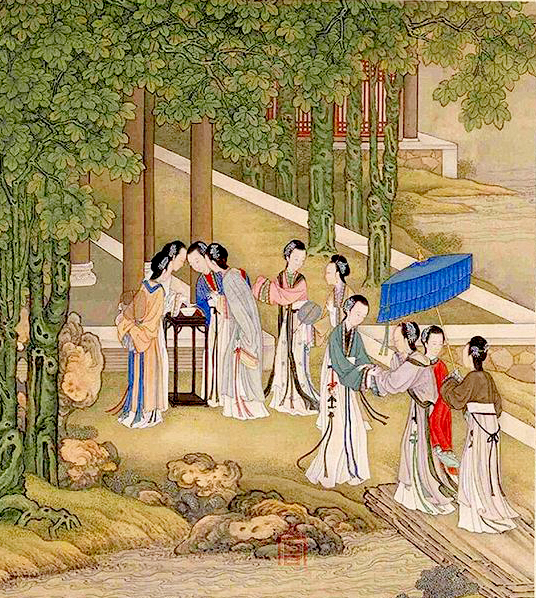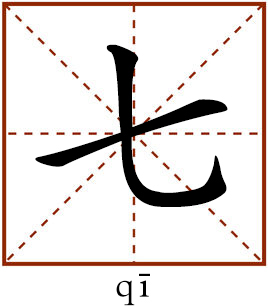Qixi Festival: More than just romance

“Qi Qiao” by the Qing artist Chen Mei, offering a view of the game of throwing needles in the Qixi Festival Photo: FILE

This character refers to the number seven. Seven was widely used in ancient Chinese culture and was generally considered a propitious number.
Since their childhoods, most Chinese have become familiar with the tragic romance between the Weaving Maid (Zhi Nü), and the Cowherd (Niu Lang). The couple is permitted to meet once a year during the Qixi Festival, which falls on the seventh night of the seventh lunar month. The Qixi, also known as the Magpie Festival or the Seventh Night Festival, is a traditional festival full of romance and was important to ancient ladies.
There are various beliefs about the origin of the festival. According to a generally accepted version dating as far back as the Spring and Autumn Period (770-476 BCE), the date of Qixi was originally fixed based on the location of Zhinü Xing in the sky, which refers to the trio of stars consisting of Vega, ε Lyrae and ζ1 Lyrae. These three stars form a triangle. Ancient Chinese noticed that the internal angle with Vega as its vertex usually faced the east in early autumn during the seventh lunar month. It was considered promising a harvest.
The seventh day of the seventh lunar month is special, partly due to the cultural significance of chong ri (literally, double day) in the Chinese calendar. Chong ri refers to January 1 (New Year’s Day), February 2 (Spring Dragon Festival), March 3 (Outing Festival), May 5 (Dragon Boat Festival), June 6, July 7 (Qixi Festival) and September 9 (Climbing Festival). These seven days were treated as auspicious days. Because the tone of number 7 is quite similar to that of the character ji (blessings), July 7 was regarded as a day of double ji. Hence, the date of the Qixi Festival was set on July 7 in the Chinese calendar.
Qi Qiao
Although the Qixi Festival nowadays is widely recognized as Chinese Valentine’s Day due to the romantic legend, it originated from an annual celebration named Qi Qiao by girls and women in bygone days. Qi Qiao means begging for skillfulness or praying for wisdom.
In ancient times, needlework was an important aspect of the festival because it fell in early fall, when the weather was becoming cool. Women had to prepare warm clothes. An inference was drawn from The Book of Poetry that the needle work should be done before the ninth lunar month—“In Month Seven the Fire Star is hardly spotted; In Month Nine winter coats are allotted.” Therefore, women probably wove in July and made clothes in August of the Chinese calendar. At that time, weaving and needlework skills were the criteria by which a girl’s hands and mind were judged, both prerequisites for being a good wife and mother. Since Zhi Nü was regarded as a goddess of needlework who could weave textiles like roseate clouds, women began to hold ceremonial rituals in lunar July for praying to be blessed with intelligence and wisdom.
Qixi was formally listed as a festival during the Han Dynasty (202 BCE-220). Since then, festival customs have varied slightly over time, but the theme of appealing for skillfulness has remained unchanged.
Needlework game
Girls in ancient times longed to have good weaving skills as Zhi Nü had, so they would compete with each other to see who was the best weaver. Needlework competition, or chuan zhen qi qiao, was the original activity of the festival. The earliest-known reference to this activity dates back to the Han Dynasty. As recorded in Miscellany of the Western Capital (Xi Jing Za Ji), an unofficial record of historical events written some 1,600 years ago, on the seventh day of the seventh lunar month, palace maids in the Western Han Court used to compete to put threads through qi kong zhen (seven needles in line) in kai jin tower (also known as needle tower, a dwelling for women). As other women followed suit, the activity finally became a primary festival custom. Young girls gathered around and put colored threads through needles in the moonlight. The one who finished first won the game.
Spider game
Since spiders made good “weaving,” a game named xi zhu ying qiao (a lucky spider game) was created to be part of the festival activities, probably during the Northern and Southern dynasties (420-589). On the night of Qixi, women put spiders into small boxes and opened it the next morning. If the spider made a dense web inside, it was believed to represent positive feedback from Zhi Nü. The owners of those spiders would be blessed with cleverness.
The game of throwing needles
The game of throwing needles, or tou zhen yan qiao, was a variation of chuan zhen qi qiao. It became a regular custom during the Ming and Qing dynasties (1368-1912). On Qixi noon, girls usually threw a sewing needle into a bowl full of water as a test of embroidery skills. If the needle floated on top of the water, its shadow would appear near the bottom. In that case, embroidery skills would be judged by the shadow of the needle. A shadow with an elaborate shape rather than a thin line was a mark of a skilled embroider.
Qixi offering
The Qixi offering was an important and necessary part of the annual celebration based on the worship to Zhi Nü. In the old days, young girls and women gathered on that night. Parents would invite their relatives’ daughters (for at that time, ladies rarely went out), because their daughters would much more likely enjoy the festival with her female friends. On the day before the festival, they used to fast and take a bath. On the night of July 7, they held the ceremony in front of a table with abundant offerings like fruits, wine and wu zi, which included longan, red dates, hazelnuts, peanuts and melon seeds. Prayers were offered, the altars lit, and the odor of incense filled the air. After that, they gathered around in the moonlight, sharing peanuts and melon seeds and sending messages to Zhi Nü. Single women usually prayed for finding a good husband in the future, and the newly married women prayed to become pregnant quickly.
Growing beans
Growing beans, or zhong sheng, in which sheng means bearing children, was another old custom of the festival. Approaching that day, families grew beans in bowls. On July 7, they tied the sprouts of beans with red and blue threads, referring to zhong sheng. There were also various waxworks of Niu Lang and Zhi Nü, animals or others. They were put into water, called shui shang fu, which means floating on top of water. The models of infants made of wax were popular with women. They were put into water or soil and named hua sheng, symbolizing more children for families.
Qiao guo
Qixi includes consuming various types of food, and these differ from region to region. The most popular of them is the qiao guo (skillful fruit, literally). It was a type of fried thin paste of different shapes, made from oil, flour, sugar and honey. To make it, after boiling sugar into syrup, flour and sesame seeds are added and mixed into a dough. Then, the dough is rolled out until it is very thin. It is cut into squares and folded into fusiform shapes (wide in the middle, tapering at the ends). The last step is to fry the pastries until they turn yellow.
Qi Qiao fair
During the Song and Yuan dynasties (960-1368), there were great fairs for the festival in the national capital, called Qi Qiao Shi, or Qi Qiao fairs. The fair was a big event for the whole city. On July 1, people started garthering at the fair and families came in huge groups. The roads were crowded with people and carriages. There were stalls all round, full of things from domestic markets and from foreign lands. All kinds of festival foods were sold. In the few days before July 7, the whole fair was converted into a huge carnival. There was no space to move about freely amid the atmosphere of excitement.
(edited by REN GUANHONG)
